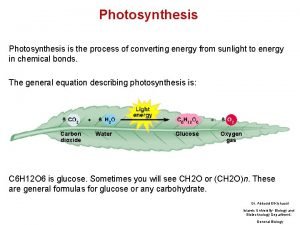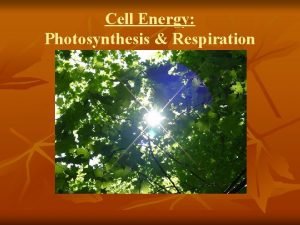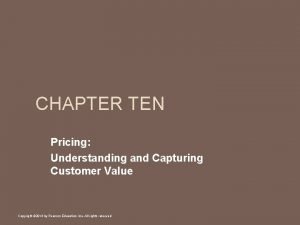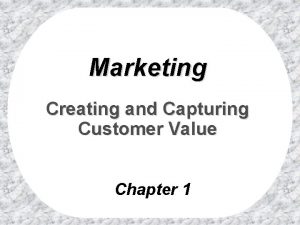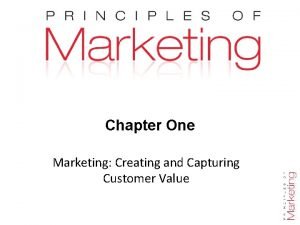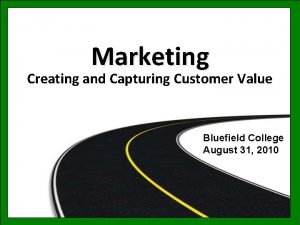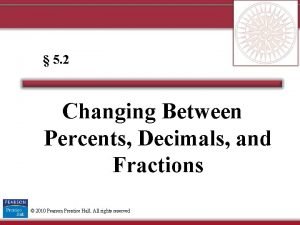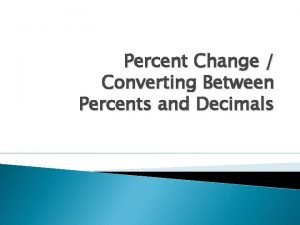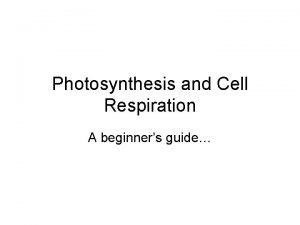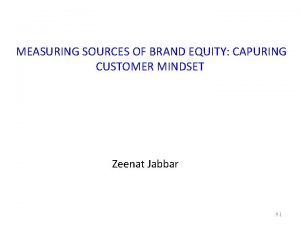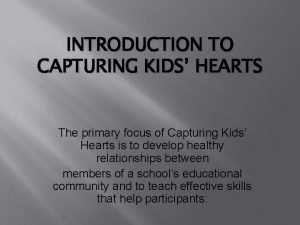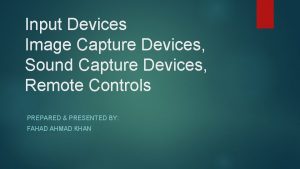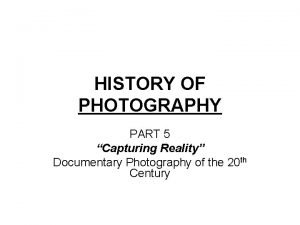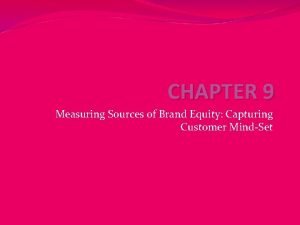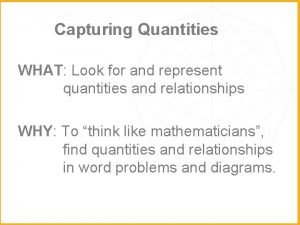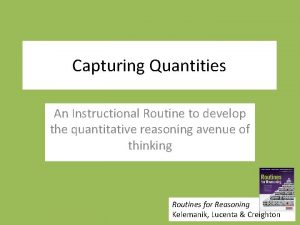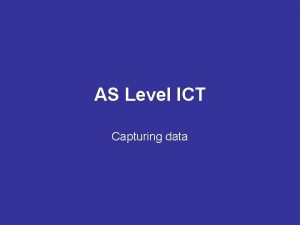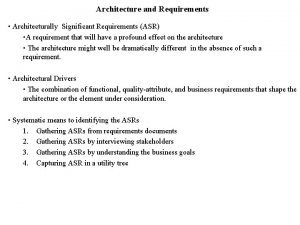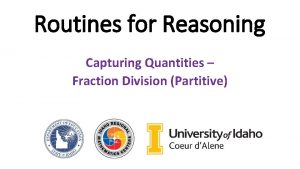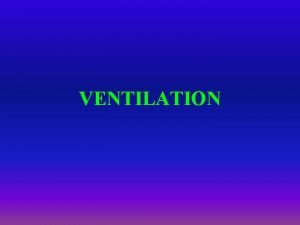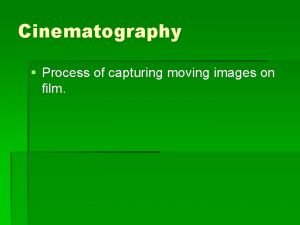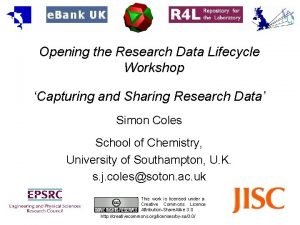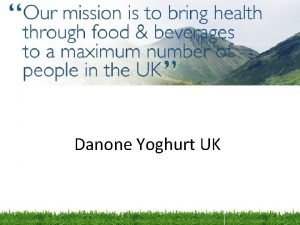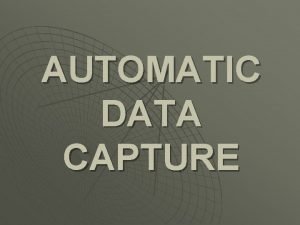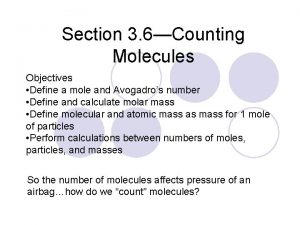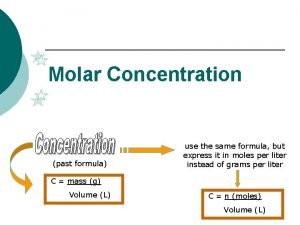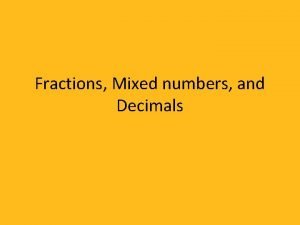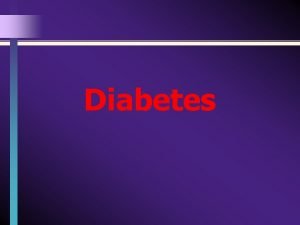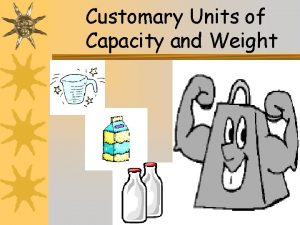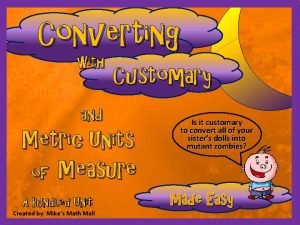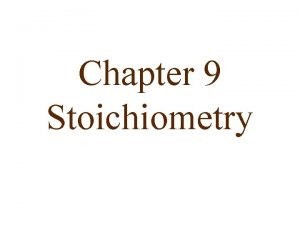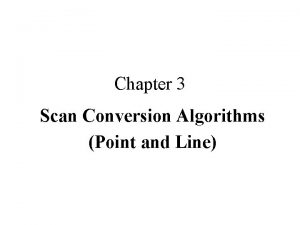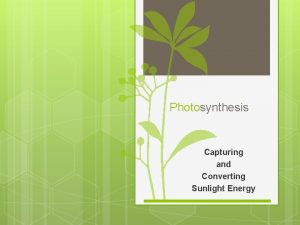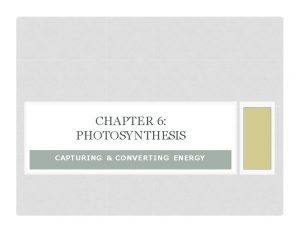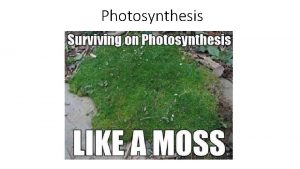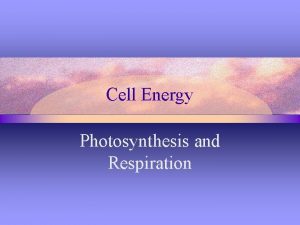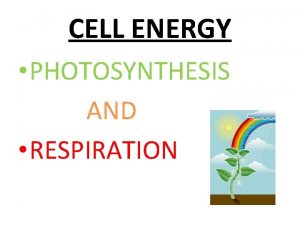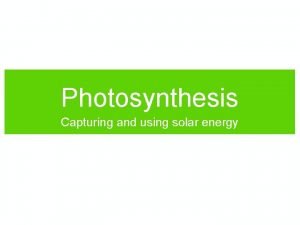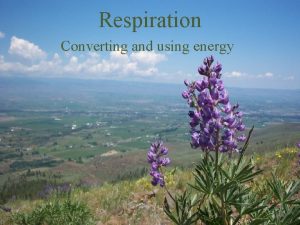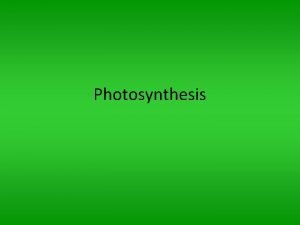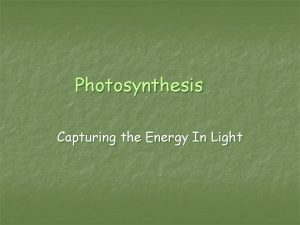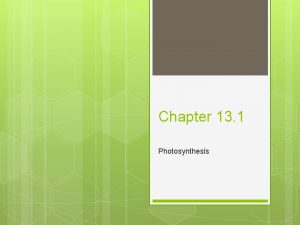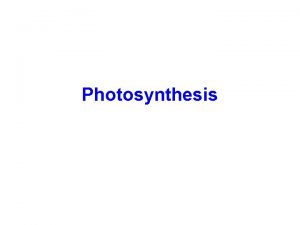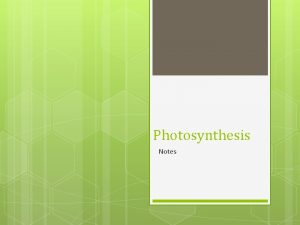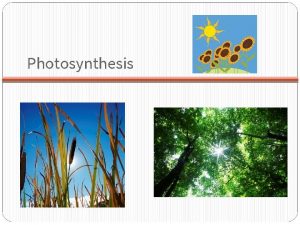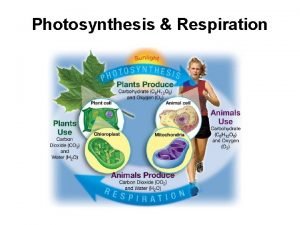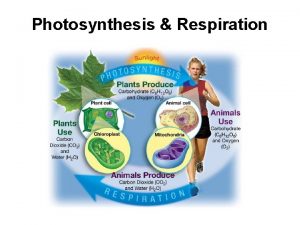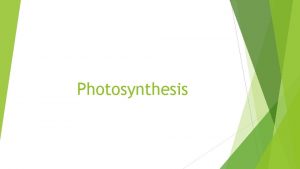Cell Energy Photosynthesis Photosynthesis Capturing and Converting Energy


























































- Slides: 58

Cell Energy Photosynthesis

Photosynthesis: Capturing and Converting Energy Photosynthesis: Plants convert the energy of sunlight into the energy in the chemical bonds of carbohydrates

Requirements for Photosynthesis Carbon + water dioxide 6 CO 2 + sunlight carbohydrates+ oxygen sunlight 6 H 2 O C 6 H 12 O 6 + 6 O 2

Other Requirements for Photosynthesis �Sunlight: Autotrophs use the energy contained in sunlight directly to produce food �Pigment: A colored substance that absorbs or reflects light • The principal pigment of green plants is known as chlorophyll

�Energy Storing Compounds: • The energy of sunlight is transferred to the electrons, raising their energy level. • Similar how are used to solar cells produce electrical currents.

Two Methods of Capturing Sunlight Energy 1. NADPH =an energy carrier NADP+ (the low energy form) accepts high energy electrons in plants and is converted to NADPH. Essentially, the sunlight energy is captured and trapped in chemical form.

2. ATP - Adenosine Triphosphate Energy is captured in the chemical bonds between phosphate groups = High Energy!

• Energy is required to attach the second and third phosphate groups to AMP (adenosine monophosphate) o Adding a phosphate group is like adding battery bars to your cell phone

• Energy is stored in the bonds between phosphate groups. • Energy is released when the phosphate groups bonds are broken.

The Chloroplast: grana thylakoids stroma Thylakoids: Saclike photosynthetic membranes • Light dependent reaction occurs here • Contains clusters of chlorophyll

The Chloroplast: thylakoids The energy storage molecules ATP & NADPH are made here by capturing the energy of sunlight.

The Chloroplast: grana thylakoids stroma Grana: Stacks of thylakoids Stroma: The region outside thylakoids. • Energy stored in ATP & NADPH is used to make carbohydrates.

Photosynthesis: The Light Reactions & Calvin Cycle Light energy CO 2 Glucose C 6 H 12 O 6 Light dependent reactions Calvin Cycle H 2 O NADP+ NADPH ADP + P ATP O 2 - Oxygen

Summary of the light reactions: Use H 2 O, ADP, NADP+ and sunlight energy to produce O 2, ATP, and NADPH. ATP & NADPH are needed for the Calvin Cycle! Dependent Reactions Video

Summary of the Calvin Cycle (light independent reactions)

Summary of Calvin cycle (Light Independent Reactions): Uses 6 CO 2 molecules, ATP, and NADPH to produce C 6 H 12 O 6, ADP, and NADP+. Calvin Cycle Video

Comprehension Questions 1. Where are the light dependent reactions occurring? thylakoid membrane 2. Where is water broken down or split? light dependent reactions 3. ATP and NADPH are produced during which process? Light dependent reactions

4. How is NADPH produced in this process? High energy electrons are passed to NADP+ in order to make NADPH 5. Where does the Calvin cycle take place? stroma

6. What enters the Calvin cycle from the atmosphere? CO 2 7. ATP and NADPH are formed during which phase of photosynthesis? Light reactions 8. What is the product of the Calvin cycle? glucose

9. What factors affect the rate of photosynthesis? (Try to come up with 5 factors ) Light intensity, light color, temperature, CO 2 levels, amount of water


Internal Structure of a Leaf - it is like a sandwich!

Epidermis: A layer on top and on bottom, like skin.

Palisade mesophyll layer: main photosynthetic layer, beneath the upper epidermis, packed with chloroplasts.

Spongy mesophyll layer: between palisade & lower epidermis (filled with air sacs).

Vein: Composed of xylem (water transport) & phloem (sugar transport) running through the mesophyll layer.


Cuticle: Waxy covering on the upper epidermis that holds water in.

Stomata: Small openings in the lower epidermis that can open or close using guard cells to allow gas exchange with the environment.

Stomata close when conditions are dry.

Stomata open when the plant has enough water.

Ecology: Study of the interactions of organisms with one another and their physical surroundings. Levels of Organization *The biosphere is the part of the earth in which life exists. -Including the air, water and land.

Levels of Organization • Ecosystem: a collection of all of the biotic (living) factors in a particular area, together with the abiotic (nonliving) factors that influence their environment. . *Examples of abiotic factors: water, sunlight, soil type, rocks, temperature, humidity, elevation, and rainfall

Levels of Organization • Ecosystem: a collection of all of the biotic (living) factors in a particular area, together with the abiotic (nonliving) factors that influence their environment. . *Examples of abiotic factors: water, sunlight, soil type, rocks, temperature, humidity, elevation, and rainfall *Examples of biotic factors: fish, frogs, insects, snails, worms, amoebas, and waterlillies


Levels of Organization • Ecosystem example: Forest Preserves • Community: All the populations of organisms living in a defined place. Example: • Population: A group of individuals that belong to the same species in a given area. Example:

• Species: A group of individuals so similar that they can breed and produce fertile offspring.

The Flow of Energy in Ecosystems: Building the WEB of Life Energy: is a one-way flow through the ecosystem (not recycled)

The Flow of Energy in Ecosystems: Food Chain: a series of steps in which organisms transfer energy by eating and being eaten.

Food Web: a network of food chains in an ecosystem. Draw arrows to complete the web.

Trophic level: the feeding position of an organism in a food chain or food web. Food chains and food webs start with producers as the 1 st trophic level.

Producers: Organisms that make their own food AKA autotrophs. Types of autotrophs: *Photosynthetic ( plants & algae )

Producers: Organisms that make their own food AKA autotrophs. Types of autotrophs: *Photosynthetic ( plants & algae *Chemosynthetic ( some bacteria ) )

Consumers: get energy directly or indirectly from producers. AKA heterotrophs. Primary consumer = 1 st consumer level, eat producers, called herbivores. Secondary consumer = 2 nd consumer level, eat primary consumers, called carnivores or omnivores. Tertiary consumer = 3 rd consumer level, eat secondary consumers.

Ecological Pyramids: diagrams that show the relative amount of energy or matter at each trophic level in a food chain or food web.

1. Pyramid of Energy: illustrates the total amount of incoming energy at each trophic level. Only 10% of the energy from one trophic level is transferred to (or can be used by) the next trophic level. Where does the rest of the energy go?

2. Pyramid of Biomass: illustrates the total mass of living tissue at each trophic level. Which level has the most biomass? Explain why:

3. Pyramid of Numbers: illustrates the total number of organisms at each trophic level. Make a conclusion about the pyramid of numbers for the grassland.

Compare the grassland pyramid with the tree pyramid. Identify one difference and one similarity between the two pyramids aside from the types of organisms.

Identify the following ecological pyramids: Pyramid of Biomass Pyramid of Numbers Pyramid of Energy

Populations within communities interact with one another in many ways. Symbiosis: Any relationship in which two species live closely together organisms and at least one species benefits. “sym-” = together “-bios” = life

What are the different kinds of symbiosis? Mutualism Commensalism Parasitism both species benefit one species benefits, one species is unaffected one species benefits, one species is harmed

Examples of Symbiotic Relationships Mutualism: Both species benefit from the Example 1: Otters and Kelp relationship The otters help the kelp by eating the sea urchins which endanger it. The kelp provides an anchor for the otters while they sleep.

Example 2: Cleaner Fish and the Moray Eel • The cleaner fish eats parasites and food bits out of the inside of this moray eel. It gets a meal and is protected from predators by the fierce eel.

Commensalism: One member of the association benefits and the other is neither helped nor harmed. Example 1: The cattle egret and cows The cattle help the egret who look for grasshoppers and beetles that are raised by the cows. Now and then they sit on the back of a cow, looking for ticks and flies. This does not effect the cattle in any way.

Example 2: Barnacles and Whales • Barnacles need a place to anchor. They must wait for food to come their way. Some barnacles hitch a ride on unsuspecting whales who deliver them to a food source. This does not effect the whale in any way.

Parasitism: One species benefits while the other is harmed Example 1: Mistletoe and Tree Mistletoe is an aerial parasite that has no roots of its own and lives off the tree that it attaches itself to. Without that tree it would die. It slowly chokes out the life of the host tree.

Example 2: Bedbugs and Humans Bedbugs are small, nocturnal parasites that come out of hiding at night to feed on unsuspecting humans. They feed exclusively on blood! Their bites often result in an allergic reaction.
 Photosynthesis is the process of converting
Photosynthesis is the process of converting Chapter 6 cell energy photosynthesis and respiration
Chapter 6 cell energy photosynthesis and respiration Photosynthesis transforms light energy into chemical energy
Photosynthesis transforms light energy into chemical energy Pricing: understanding and capturing customer value
Pricing: understanding and capturing customer value Capturing value from customers
Capturing value from customers Creating and capturing customer value
Creating and capturing customer value A simple model of the marketing process
A simple model of the marketing process Creating value and capturing value
Creating value and capturing value Percents to decimals
Percents to decimals Converting between percents decimals and fractions
Converting between percents decimals and fractions Photosynthesis equation
Photosynthesis equation Capturing kids hearts four questions
Capturing kids hearts four questions Kevin kotler net worth
Kevin kotler net worth Qualitative research techniques to measure brand equity
Qualitative research techniques to measure brand equity Excel model capturing kids hearts
Excel model capturing kids hearts Input devices for capturing images
Input devices for capturing images Capturing reality documentary
Capturing reality documentary Measuring sources of brand equity
Measuring sources of brand equity Capturing quantities
Capturing quantities Capturing quantities
Capturing quantities What is data capturing with example
What is data capturing with example Asr architecture
Asr architecture Capturing quantities
Capturing quantities Industrial ventilation hood
Industrial ventilation hood The process of capturing moving images on film
The process of capturing moving images on film Data capturing workshop
Data capturing workshop Capturing marketing insights
Capturing marketing insights Swot analysis of sari sari store
Swot analysis of sari sari store Automatic data capture
Automatic data capture Advantages of diaphragm cell
Advantages of diaphragm cell Prokaryotic cell and eukaryotic cell similarities
Prokaryotic cell and eukaryotic cell similarities Venn diagram plant vs animal cells
Venn diagram plant vs animal cells Vacuole function
Vacuole function Plant and animal cell
Plant and animal cell Lead acid battery primary or secondary
Lead acid battery primary or secondary Difference between plant cell and bacterial cell
Difference between plant cell and bacterial cell Cell cycle and cell division
Cell cycle and cell division Prokaryotic cell and eukaryotic cell
Prokaryotic cell and eukaryotic cell Chapter 4 cell theory and cell study
Chapter 4 cell theory and cell study Idealized animal cell and plant cell
Idealized animal cell and plant cell Walker cell and hadley cell
Walker cell and hadley cell Cell cycle and cell division
Cell cycle and cell division Venn diagram animal and plant cells
Venn diagram animal and plant cells Cell cycle chart
Cell cycle chart Difference between galvanic cell and electrolytic cell
Difference between galvanic cell and electrolytic cell Rigid outer covering of plant cells
Rigid outer covering of plant cells How to go from molecules to moles
How to go from molecules to moles Scan conversion of circle
Scan conversion of circle Molar mass to grams
Molar mass to grams Mass concentration formula
Mass concentration formula Recurring decimal
Recurring decimal Mixed number to decimal
Mixed number to decimal It is a disease that prevents the body from converting
It is a disease that prevents the body from converting Prius c plugin
Prius c plugin Customary units capacity
Customary units capacity Why does the us use customary units
Why does the us use customary units What is the basis of scan conversion of circle
What is the basis of scan conversion of circle Converting grams to moles
Converting grams to moles Scan converting a point
Scan converting a point
